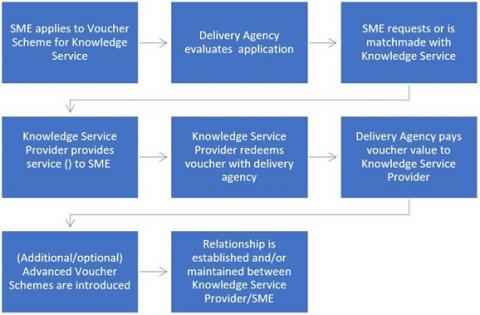Voucher schemes: zooming in on innovation vouchers

Innovation vouchers are small lines of credit (usually ranging from €2000 to €20,000) provided by regional or national governments to Small- and Medium-sized Enterprises (SMEs) to purchase services from knowledge providers such as universities, research centres, or consulting firms with a view to introducing new products, processes, or services in their business operations.
Innovation vouchers have three main objectives:
- To stimulate the introduction of product, process, organisational or service innovation in SMEs, which tend to lack leading-edge knowledge compared to large companies or innovative start-ups.
- To promote science-industry collaboration and stimulate knowledge transfer. Indeed, SMEs tend to have limited exchanges with universities and research centres due to information asymmetries such as the cost linked to the identification of relevant information providers. Moreover, universities and research centres tend to have difficulties in finding users of their research.
- To foster the formation of networks between SMEs and other academic, research and private partners. Innovation vouchers can be the catalysts for longer-term relationships and collaboration (Innovation Policy Platform).
Innovation vouchers have gained in popularity as a key policy tool in the regional research and innovation policy-mix. Indeed, innovation vouchers are less complex policy tools compared to more complex forms of support such as loans and subsidies. They are considered as agile policy tools with relatively low public investment involving less administrative burden, thus allowing to target SMEs.
The elements of success of innovation voucher schemes are:
- All the actors participating in an innovation voucher scheme must benefit from the program. When the innovation voucher promotes university-industry collaboration, both SMEs and universities must benefit and learn from one another. Key Performance Indicators (KPIs) such as increased collaboration and interactions between SMEs and universities could measure the success of the innovation voucher scheme.
- SMEs applications must be simple and as 'light-touch' as possible considering the small 'lump-sum' provided by the voucher.
- The voucher should also be directly administrated by a public agency (rather than a university) as it avoids potential conflict of interest, reduces the burden on the knowledge provider and may allow greater scope for follow through with other types of government support for innovation.
- Innovation voucher schemes must be place-based to respond to regional research and innovation weaknesses and challenges. The innovation voucher scheme must reflect the state of regional economic development, sectoral prioritisation (alignment with S3 priorities), and regional industrial and economic structures to be the most effective.
- Innovation voucher schemes require the public agency in charge of the program to have effective brokering capacity to identify and match partners and organisations.
Image

Figure 1. The main stages of a voucher scheme. Source: EURADA.
In Horizon 2020, innovation vouchers can be distributed through cascade financing, also known as Financial Support to third parties, a mechanism of the European Commission to distribute public funds through projects and intermediary organisations in order to create new companies, increase their scalability, support SMEs and/or mid-cap companies in the adoption or development of digital innovation (European Commission). The main objective of cascade funding is to simplify the procedures of financing private companies and innovative actors by allowing the projects, that are already financed by the EU, to run open calls for financing smaller projects.
Discover how interregional cooperation with Interreg Europe helped many regions in Europe to make their innovation vouchers even more effective thanks to the good practices and lessons learnt by other regions and institutions across the EU.
